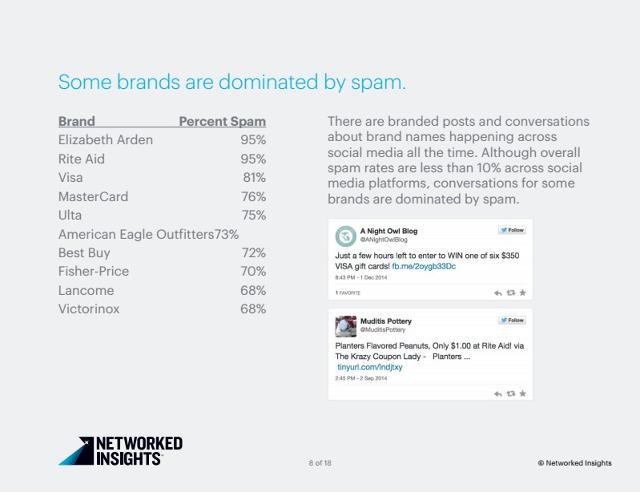nearly 10% Of Twitter Is junk mail
that’s in keeping with Networked Insights, which discovered that brands especially are subject to having their hashtags hijacked for unrelated use.
April 1, 2015
It’s no secret that vast manufacturers use Twitter as the world’s largest focal point workforce. companies maintain their ears pressed up towards the wall by the use of social media, decided to suss out what their shoppers think of them. It’s also no secret that social media knowledge is stuffed with “noise”—messy, useless, irrelevant knowledge. Now, a brand new study finds that much of that “noise” is generated with the aid of hyperlinks to coupon web sites and celebrity retweets.
Networked Insights, a Chicago-based analytics firm, just lately launched a document claiming a number of the world’s best possible-identified brands are essentially talked about on Twitter, fb, and other social media systems in the form of unsolicited mail, coupons, or grownup content material—essentially, their manufacturers are hijacked to trap unsuspecting customers to click on thru to unrelated subject matter. consistent with Networked Insights’ analysis, 95% of the mentions of ceremony help on social media are unsolicited mail messages, as are mentions of Elizabeth Arden. Visa has an outstanding eighty one% junk mail price, as does rival MasterCard, with 76%. Seventy % of mentions of Fisher-price toys on social media are spam, whereas sixty eight% of the mentions of cosmetics firm Lancome don’t have anything to do with customers in reality discussing the cosmetics. (while Networked Insights failed to verify whether or not these corporations were purchasers, a scan of the manufacturers’ social streams via Twitter and Topsy gave the impression to again up the frequency of unsolicited mail in each case.)

Jaime Brugueras, Networked Insights’ vice president of analytics, explained that his group finds three completely different forms of noisy social media posts (which they known as “undesirable”) when inspecting Twitter, fb, and other platforms. There’s either the energetic coupon/deal trading subculture spurred by using RetailMeNot, FatWallet, and similar web sites; famous person brand tweets (which may momentarily elevate the visibility of an organization however don’t reflect its broader customer base); and junk mail for products, products and services, or grownup content that leverages the hashtags or money owed of standard manufacturers with a purpose to attain as massive an audience as possible.
in step with Networked Insights, coupons and coupon-associated posts make up 5.8% of all model dialogue on social media, adult content material is responsible for 2.2%, and common unsolicited mail is any other 1.three%. These three kinds of posts are discovered most regularly on internet boards (the place they at the same time make up 28.8% of posts), blogs, and feedback (the place spam is nineteen.6% of content material), and on Twitter (which is, as of fall 2014, 9.3% spam). The number is so high on internet forums, the authors of the find out about say, as a result of they have a tendency to have extra ads and solicitations than different boards.
one of the crucial problems entrepreneurs and firms like Networked Analytics face is the fact that spammers have become higher and better. “Spambots have become extra subtle,” Networked Insights’ vice chairman of strategic sales Brian Johnson mentioned. “some of these money owed are very troublesome; in some circumstances it can be hard to see if its a sound profile or no longer. commonly, it’s important to learn during the tweets plenty of times to peer if it can be a person or if it’s something that used to be just made to very intently imitate a human. I went to a Twitter handle not too long ago and went via forty-50 tweets that had been all scripture quotations prior to i found a link trying to promote some schlock. they are able to trick computers into considering it’s all perfectly legit content.”
And for manufacturers that use Twitter and facebook to observe client sentiment, that suggests bother. Spambots pushing doubtful pretend Viagra capsules or coupon clippers trading discount codes at no cost delivery create headaches for firms seeking to consider what beer goes with Domino’s Pizza, or what retailer mall customers visited sooner than hitting up Hollister. as the photo above presentations, doing away with spam from the equation modified the results buyers noticed significantly. “We didn’t necessarily are searching for to take into account why junk mail exists,” Johnson told me, “however we wanted it out of the gadget.”
while junk mail makes for difficulties safely studying shopper sentiment, in some ways it way brands are on track. spam and adbots may well be irritating, but the hashtags manufacturers use are designed to trap as many eyeballs as conceivable. In a twisted approach, being spamjacked simply means a brand is doing their job of being ubiquitous.
fast company , learn Full Story
(221)














